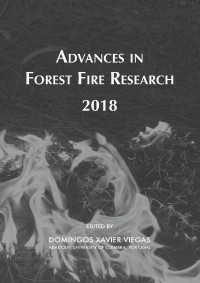Please use this identifier to cite or link to this item:
https://hdl.handle.net/10316.2/44581| DC Field | Value | Language |
|---|---|---|
| dc.contributor.author | Ambroz, M. | |
| dc.contributor.author | Mikula, K. | |
| dc.date.accessioned | 2018-11-09T14:08:58Z | |
| dc.date.accessioned | 2020-09-06T17:31:30Z | - |
| dc.date.available | 2018-11-09T14:08:58Z | |
| dc.date.available | 2020-09-06T17:31:30Z | - |
| dc.date.issued | 2018 | - |
| dc.identifier.isbn | 978-989-26-16-506 (PDF) | |
| dc.identifier.uri | https://hdl.handle.net/10316.2/44581 | - |
| dc.description.abstract | We introduce new Lagrangian surface forest fire spread model, which is based on the evolution of a three dimensional surface curve representing the fire perimeter on the topography. We split the general motion of any point of the surface curve into the normal and tangential directions. The velocity in the normal direction is given by the rate of spread, i.e. it depends on the local characteristics of fuel, terrain slope, wind speed and velocity and shape of the fire perimeter with respect to the topography (geodesic and normal curvature). The velocity in the tangential direction, which does not change the shape of the fire perimeter, is used to redistribute the curve points asymptotically uniform along the curve. This surface curve is projected into the horizontal plane as a planar curve, which evolution is numerically computed and evolved curve is mapped back to the surface. For the numerical computations we discretize the arising intrinsic partial differential equation by a semi-implicit scheme in curvature term and for the advection term we use the so-called inflow-implicit/outflow-explicit approach and implicit upwind technique which guarantee solvability of linear systems by efficient tridiagonal solver without any time step restriction and robustness with respect to singularities. Our fast and reliable treatment of topological changes (splitting and merging of the curves) with computational complexity O(n) is described and presented on examples as well. We demonstrate the influence of the fire spread model parameters on a testing and real topography. | eng |
| dc.language.iso | eng | - |
| dc.publisher | Imprensa da Universidade de Coimbra | por |
| dc.relation.ispartof | http://hdl.handle.net/10316.2/44517 | por |
| dc.rights | open access | - |
| dc.subject | forest fire modelling | eng |
| dc.subject | surface curve | eng |
| dc.subject | curve evolution | eng |
| dc.subject | topological changes | eng |
| dc.subject | inverse modelling | eng |
| dc.title | New Lagrangian surface forest fire propagation model | por |
| dc.type | bookPart | por |
| uc.publication.firstPage | 577 | - |
| uc.publication.lastPage | 587 | - |
| uc.publication.location | Coimbra | por |
| dc.identifier.doi | 10.14195/978-989-26-16-506_64 | - |
| uc.publication.section | Chapter 3 - Fire Management | por |
| uc.publication.digCollection | PB | por |
| uc.publication.orderno | 64 | - |
| uc.publication.area | Ciências da Engenharia e Tecnologias | por |
| uc.publication.bookTitle | Advances in forest fire research 2018 | - |
| uc.publication.manifest | https://dl.uc.pt/json/iiif/10316.2/44581/204207/manifest?manifest=/json/iiif/10316.2/44581/204207/manifest | - |
| uc.publication.thumbnail | https://dl.uc.pt/retrieve/11058771 | - |
| uc.publication.parentItemId | 55072 | - |
| uc.itemId | 68846 | - |
| item.grantfulltext | open | - |
| item.fulltext | With Fulltext | - |
| Appears in Collections: | Advances in forest fire research 2018 | |
Files in This Item:
| File | Description | Size | Format | |
|---|---|---|---|---|
| new_lagrangian_surface_forest_fire.pdf | 1.5 MB | Adobe PDF |  |
Items in DSpace are protected by copyright, with all rights reserved, unless otherwise indicated.
